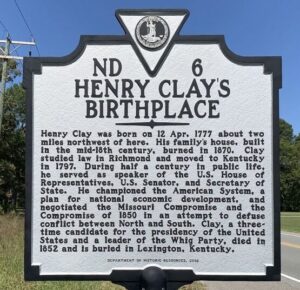Does the spirit of a renowned statesman linger at the estate that he helped to build in Lexington, Kentucky? Let’s start with a look at his roots in Central Virginia…
On a fateful day, April 12, 1777, in the heart of Hanover County, Virginia, a future titan of American politics was born. Henry Clay, the seventh of nine children, entered the world at the Clay homestead, under the watchful eyes of the Reverend John Clay and Elizabeth Clay.
In 1781, tragedy struck as the Reverend John Clay passed away, leaving his family vulnerable amidst the chaos of the Revolutionary War. The British raided their homestead, plunging the family into economic uncertainty. Hope would emerge when the widow Elizabeth Clay married Captain Henry Watkins in 1782. Watkins, a prosperous planter and cousin to John Clay, became a beacon of support and kindness, forging a strong bond with young Henry Clay.
In 1791, Watkins relocated the family to Kentucky, but Henry Clay’s fortunes took him in another direction. His stepfather secured him a position in a Richmond emporium, with the promise that Clay would eventually receive a clerkship at the Virginia Court of Chancery. Clay only needed to wait about a year for his opportunity, and he quickly adapted to the clerkship, earning him the attention of College of William & Mary professor George Wythe, a signer of the Declaration of Independence and judge on Virginia’s High Court of Chancery (and a man with his own haunting tale). Hampered by a crippled hand, Wythe chose Clay as his secretary, a role in which Clay would remain for four transformative years.
Under Wythe’s mentorship, Clay’s legal acumen flourished, and his vision of the United States as a beacon of freedom was solidified. Clay’s journey continued as he worked for the Virginia attorney general, completed his studies, and was admitted to the Virginia Bar in 1797. With his sights set on new horizons, Clay embarked on a westward journey to Kentucky, where his career would reach new heights.
On April 11, 1799, Henry Clay’s life took a significant turn as he married Lucretia Hart at her family’s home in Lexington, Kentucky. Her father, Colonel Thomas Hart, became more than just a supportive father-in-law; he was a vital business ally, helping Clay expand his clientele and elevate his professional standing.
Henry and Lucretia Clay initially resided in Lexington, but in 1804, they embarked on building a plantation known as Ashland, just outside the city. Clay’s vision began with the purchase of 125 acres, a year after his election to the state legislature. Between 1813 and 1815, the estate expanded with the addition of two wings, mirroring Clay’s rise in both personal and professional spheres. His roles as a member of the United States House of Representatives, Speaker of the House, Law Professor at Transylvania University, and United States Senator were testament to his growing influence.
Henry Clay’s political prowess earned him the moniker “The Great Compromiser,” a testament to his relentless efforts to prevent a schism in the union and avert war between the North and the South. Yet, this accolade was a double-edged sword in his political journey. Despite his illustrious career, the Presidency eluded him. Clay ran for the highest office three times—in 1824, 1832, and 1844—each time facing defeat, largely due to his stance and compromises on the contentious issue of slavery. As a lifelong slaveholder, Clay incurred the wrath of northerners, while his advocacy for the curtailment of slavery earned him the distrust of southerners. Though this is a simplified account, it underscores the pivotal role slavery played in shaping public opinion during that era.
Henry Clay’s legacy extends beyond his distinguished political career. On his sprawling 600-acre farm, he made significant strides in cattle and horse breeding, showcasing his multifaceted talents and dedication to agricultural pursuits.
Henry and Lucretia Clay’s enduring partnership lasted until his death in 1852. Lucretia lived until 1864, passing away at the age of 83. Their final resting place is Lexington Cemetery, where they are buried side by side.
Upon Henry Clay’s death in 1852, his son James inherited Ashland. By 1857, the original house had fallen into disrepair, prompting James to tear it down and rebuild. He preserved the foundation but reimagined the home on a grander scale, maintaining the original floor plans while enhancing its splendor.
Stepping into the entryway of Ashland, visitors are greeted by exquisite ash woodwork, Pompeiian red walls, and ornate gilt cornice and medallion decor. James Clay’s vision brought marble fireplaces and other stunning additions, including the octagonal library with its majestic domed ceiling.
Following James Clay’s death in 1864, the Ashland estate transitioned to Kentucky University, only to return to the Clay family in 1878. Henry Clay’s descendants resided at Ashland until 1948, when the estate was entrusted to the Henry Clay Memorial Foundation, transforming it into a historical house museum.
Today, the grand mansion of Ashland, along with its original outbuildings and formal garden, graces a 20-acre estate. Ashland stands as a museum, open to the public, and meticulously maintained by the Henry Clay Memorial Foundation.
Henry Clay’s affection for Ashland was profound. It served as a sanctuary where he could indulge in his farming interests and refine his political oratory. Perhaps this is why some have sensed his presence in the parlor, one of his cherished spaces. He is often described as a white-haired figure in a black frock coat, leaning against the fireplace mantel. Though the house has been rebuilt, Clay’s spirit may still find solace in the legacy of his son’s achievements that continue to resonate within its walls.


